I should remind myself not to listen to the media (even the public broadcaster) when…
Australian labour force data reveals a failed federal economic strategy
A few weeks ago the Federal government admitted that its obsessive pursuit of a budget surplus in the coming year at a time when private spending is still relatively weak was doomed. The slowing Australian economy had undermined its tax base as was always going to happen. The problem is that in trying to impose fiscal austerity the economy has suffered and the labour market is not producing enough jobs to even match the underlying population growth. Today’s release by the Australian Bureau of Statistics (ABS) of the Labour Force data for December 2012 reveals that all the evils on the demand and supply side of the labour were aligned – total employment fell, full-time employment fell, unemployment rose, participation eased and working hours fell. It is certain that underemployment rose given the drop in working hours. In other words, the data is unambiguously bad. The unemployment rate rose to 5.4 per cent. The data is not consistent with any notions that the Australian labour market is booming or close to full employment. The most continuing feature that should warrant immediate policy concern is the appalling state of the youth labour market. My assessment of today’s results – a failing economy with further weakness to come. The Government should wake up to itself and even if only motivated by the federal election later this year it should reverse the direction of fiscal policy and introduce some direct job creation by way of employment-targetted stimulus.
The summary ABS Labour Force (seasonally adjusted) estimates for December 2012 are:
- Employment decreased 5,500 (0.05 per cent) with full-time employment falling by 13,800 and part-time employment rising by 8,300.
- Unemployment increased 16,600 (2.6 per cent) to 656,400.
- The official unemployment rate increased 0.1 points to 5.4 cent from 5.3 per cent (on revised last month estimates).
- The participation rate remained steady at 65.1 per cent (in fact it fell slightly at the two decimal point level).
- Aggregate monthly hours worked decreased 1.1 million hours (0.1 per cent).
- The quarterly ABS broad labour underutilisation estimates (the sum of unemployment and underemployment) are published on a quarterly basis (last published November). In November the total labour underutilisation rate was rising and stood at 12.5 per cent. With the continued decline in full-time employment and total hours declining plus the rise in unemployment it is certain that the broad rate has increased in the last month – perhaps by around 0.3 points.
There was a headline story this morning in the Fairfax press (January 17, 2013) – Blackrock gives thumbs up to local economy – which summarises what is wrong with the world of economics.
It was written prior to today’s Labour Force results, but that hardly matters, given that the data today was totally predictable. Indeed for once, the bank economists got it right. They say that all forecasters eventually get it right once in a while – even the IMF. The problem is the damage they cause in the interim with their error-prone forecasts.
The Blackrock article said that:
… the world’s biggest fund manager … BlackRock is one of the world’s most important buyers of governments bonds. It says Australia’s carbon tax and the mining tax have had at most a “marginal” impact on perceptions of country risk. More important has been the government’s success in shrinking its budget deficit.
Its new sovereign risk update ranks Australian government bonds as the world’s seventh least risky, up from 10th three months ago. No other nation has jumped three places in the latest survey.
Now today’s blog is about the labour market data so I will be brief.
1. Blackrock thinks it is appropriate to conflate within its rankings nations that issue their own currency and those that do not. That makes their rankings meaningless.
2. Blackrock thinks a nation that issues its own currency carries “sovereign debt risk”. They do not which makes their rankings meaningless.
3. Blackrock thinks a nation that “Whether you are looking at budget balance or public debt to gross domestic product, whichever way we look at it, Australia comes out exceedingly strong”, which means it is trapped in the circular logic I wrote about yesterday – IMF locked into circular (religious) logic again. In other words, their rankings are meaningless.
4. Blackrock thinks a nation that imposes fiscal austerity on its people and forces more into unemployment is a “very, very strong” performer. That makes them as culpable as the rest of the scandalous organisations that swan around advocating impoverishment of workers.
5. Blackrock thinks that private bond markets control yields. The reality is that they do so only because governments (central banks and treasury) let them and when the yields become inconvenient politically they do not let them. Even in the Eurozone, the ECB has dealt the bond markets out of the game when it became obvious they were not serving any reasonable interests.
6. The Federal government “welcomed the report as an ‘endorsement of Australia’s strong public finances'” which means they neither understand how the economy they are in charge of works and/or they are prepared to deliberately use these meaningless indicators for political purposes while they know their economic policy is pushing thousands into unemployment.
So there was discussion in the press Blackrock and self-praise type assessments without any mention of the sort of concerns I raise above (Peter M – why not challenge the logic of the rankings vis-a-vis what really matters!).
Then mid-morning (East Coast time), the Labour Force data came out and the reality check arrives. The labour market is contracting and more people are being pushed onto the jobless queue to be forced by government policy to live on income support which is below the poverty line by a long way! Sounds like a failing economy to me.
How do low bond yields help those forced out of work? As a worker and his/her family start to lose their life savings as they enter unemployment – because the government austerity is causing demand to shrink – how does a low public debt ratio help them?
The ABC National News Report – Unemployment rises as full-time jobs shed – quoted some bank economist as saying:
It’s clear that the job market isn’t shooting the lights out but by no means is unemployment soaring. In a big picture sense the job market is in a holding pattern with a modest degree of softening … But while jobs are being lost in some industries, clearly they are being created in other industries.
Really. What would he be saying if he was one of the one losing their jobs (even though unemployment is not “soaring”)? Would he call that a “modest degree of softening”?
For nearly two years now the economy has been flat-lining despite having enjoyed record commodity prices for our exports. In a “big picture sense” the jobs market is failing – there is no holding pattern – it is deteriorating. The first adjustments were in participation rates (now well down on the peak) which attenuated any rise in official unemployment (replacing it with hidden unemployment).
The second adjustment is that full-time employment is in retreat and hours worked are falling.
The third adjustment is that total employment regularly contracts meaning that unemployment is slowly rising. But with total labour underutilisation around 12.5 per cent I would call that a major problem not a “modest degree of softening”.
Employment growth – negative
The December data shows that employment growth was negative again with total employment falling by 5,500 (0.05 per cent). Full-time employment fell for the second consecutive month, this time by by 13,800 while part-time employment rose by 8,300.
The further drop in full-time employment (and the decline in working hours – see later) means that underemployment will have risen in addition to the rise in unemployment.
Employment growth is currently not sufficient to absorb the growth in the labour force arising from underlying growth in the working age population. This situation will be a disaster in the early part of 2013 as school leavers flood the labour market. There are severely diminished prospects facing them.
Today’s data reasserts the message that the labour market data is switching back and forth regularly between negative employment growth and very subdued positive growth. This monthly behaviour is producing a slightly negative underlying trend, which has been fairly stable for some months now.
There have been considerable fluctuations in the full-time/part-time growth over the last year with regular crossings of the zero growth line.
The following graph shows the month by month growth in full-time (blue columns), part-time (grey columns) and total employment (green line) for the 12 months to December 2012 using seasonally adjusted data.
Today’s results just repeat the topsy-turvy nature of the data over the period shown. The Australian labour market is struggling with the declining real GDP growth creating a near jobless growth environment.
While full-time and part-time employment growth are fluctuating around the zero line, total employment growth is still well below the growth that was boosted by the fiscal-stimulus in the middle of 2010.
The following table provides an accounting summary of the labour market performance over the last six months. The monthly data is highly variable so this Table provides a longer view which allows for a better assessment of the trends. WAP is working age population (above 15 year olds). The first three columns show the number of jobs gained or lost (net) in the last six months.
The conclusion – overall only 43 thousand jobs (net) have been created in Australia over the last six months with 44 thousand full-time jobs being offset by the loss of 1 thousand part-time jobs (net). By historical standards, this represents a very miserable employment growth performance.
The WAP has risen by 149 thousand in the same period while the labour force rose by 59.2 thousand. The relatively weak employment growth has not been able to keep pace with the underlying population growth and unemployment has risen as a result (by 16 thousand).
The rise in unemployment would have been greater had not the participation rate fallen (by 0.02 percentage points), which reduced the growth in the labour force.
To put the recent data in perspective, the following graph shows the movement in the labour force and total employment since the low-point unemployment rate month in the last cycle (February 2008) to December 2012. The two series are indexed to 100 at that month. The green line (right-axis) is the gap (plotted against the right-axis) between the two aggregates and measures the change in the unemployment rate since the low-point of the last cycle (when it stood at 4 per cent).
You can see that the labour force index has largely levelled off and now falling and the divergence between it and employment growth has been relatively steady over the last several months with this month showing some improvement.
The Gap series gives you a good impression of the asymmetry in unemployment rate responses even when the economy experiences a mild downturn (such as the case in Australia). The unemployment rate jumps quickly but declines slowly.
It also highlights the fact that the recovery is still not strong enough to bring the unemployment rate back down to its pre-crisis low. You can see clearly that the unemployment rate fell in late 2009 and then has hovered at the same level for some months before rising again over the last two months.
The gap shows that the labour market is still a long way from recovering from the financial crisis that hit in early 2008. There hasn’t been much progress since December 2010, when the fiscal stimulus started to run out.
Teenage labour market – deteriorates from its already parlous state
The teenage labour market deteriorated further in December 2012. When will the media take this issue up (Peter M?).
The following graph shows the distribution of net employment creation in the last month by full-time/part-time status and age/gender category (15-19 year olds and the rest)
Over the last month, teenagers lost 3.4 thousand jobs while the rest of the workforce lost 2.1 thousand jobs. Teenagers also lost 1.5 thousand full-time job opportunities.
The conclusion is that the weak employment growth is providing no significant opportunities to teenagers to enter the employed workforce.
If you take a longer view you see how poor the situation is.
Over the last 12 months, teenagers have lost 6.4 thousand net jobs overall which the rest of the labour force have gained 154.7 thousand net jobs. Teenagers have gained 2.1 thousand full-time opportunities but lost 8.5thousand part-time opportunities in net terms.
So the Australian labour market has further undermined the opportunities for this cohort over the last year.
The teenage segment of the labour market is being particularly dragged down by the sluggish employment growth, which is hardly surprising given that the least experienced and/or most disadvantaged (those with disabilities etc) are rationed to the back of the queue by the employers.
The following graph shows the change in aggregates over the last 12 months. Australian teenagers are going backwards which is a trend common around the world at present.
To further emphasise the plight of our teenagers I compiled the following graph that extends the time period from the February 2008, which was the month when the unemployment rate was at its low point in the last cycle, to the present month (December 2012). So it includes the period of downturn and then the “recovery” period. Note the change in vertical scale compared to the previous two graphs. That tells you something!
The results are stunning and represent a major policy failure.
Since February 2008, there have been 741.1thousand (net) jobs added to the Australian economy, which by any standards is a fairly poor result.
But teenagers have lost a staggering 101.8 thousand over the same period. It is even more stark when you consider that 77.8 thousand full-time teenager jobs have been lost in net terms. Even in the traditionally, concentrated teenage segment – part-time employment – there have been 24 thousand jobs (net) lost.
Further, around 50 per cent of the total (net) jobs added since February 2008 have been part-time, which raises questions about the quality of work that is being generated overall.
Overall, the performance over the last 12 months is poor and should receive a much higher priority in the policy debate than it does.
The longer-run consequences of this teenage “lock out” will be very damaging.
The Australian government has no coherent strategy to resolve this appalling state. Ensuring teenagers are included in paid work, if they do not desire to remain in school, should be a number one policy priority.
The Government’s response is to push this cohort into endless training initiatives (supply-side approach) without significant benefits. The research shows overwhelmingly that job-specific skills development should be done within a paid-work environment.
I would recommend that the Australian government announce a major public sector job creation program aimed at employing, in the first instance, all the unemployed 15-19 year olds.
It is clear that the Australian labour market continues to fail our 15-19 year olds. At a time when we keep emphasising the future challenges facing the nation in terms of an ageing population and rising dependency ratios the economy still fails to provide enough work (and on-the-job experience) for our teenagers who are our future workforce.
Unemployment
The unemployment rate rose to 5.4 in December 2012 (up from a revised 5.3 per cent) and official unemployment rose by 16,600. The rise in unemployment would have been slightly worse given the small fall in participation – we analyse that issue in the next section.
The reality is that employment growth remains below the underlying population growth and it is only the sluggish labour force growth (being held back by these regular contractions in the participation rate) that has prevented a substantial rise in unemployment.
Overall, the labour market still has significant excess capacity available in most areas and what growth there is is not making any major inroads into the idle pools of labour.
The following graph updates my 3-recessions graph which depicts how quickly the unemployment rose in Australia during each of the three major recessions in recent history: 1982, 1991 and 2009 (the latter to capture the 2008-2010 episode). The unemployment rate was indexed at 100 at its lowest rate before the recession in each case (December 1981; December 1989; April 2008, respectively) and then indexed to that base for each of the months as the recession unfolded.
I have plotted the 3 episodes for 58 months after the low-point unemployment rate was reached. For 1991, the end-point shown is the peak unemployment which was achieved some 38 months after the downturn began although the recovery was painfully slow. While the 1982 recession was severe the economy and the labour market was recovering by the 26th month. The pace of recovery for the 1982 once it began was faster than the recovery in the current period.
It is significant that the current situation while significantly less severe than the previous recessions is dragging on which is a reflection of the lack of private spending growth and declining public spending growth.
The graph provides a graphical depiction of the speed at which the recession unfolded (which tells you something about each episode) and the length of time that the labour market deteriorated (expressed in terms of the unemployment rate).
From the start of the downturn to the 59-month point (to December 2012), the official unemployment rate has risen from a base index value of 100 to a value 135.5 – peaking at 148 after 17 months. After falling steadily as the fiscal stimulus pushed growth along (it reached 122.8 after 35 months – in December 2010), it has been slowly trending up for some months now. Unlike the other episode, the current trend, at this stage of the cycle, is unclear.
At 59 months, 1982 index stood at 146.6 and was falling, while the 1991 index was at 154.5 and had started to fall quite quickly. It is clear that at an equivalent point in the “recovery cycle” the current period is more sluggish than our recent two major downturns.
It now appears that the recoveries are converging, which tells us that the current policy has failed to take advantage of the fact that the latest economic downturn was much more mild than the previous recessions. In other words, the policy failure is locking the economy into a higher unemployment rate than is desirable and otherwise attainable.
Note that these are index numbers and only tell us about the speed of decay rather than levels of unemployment. Clearly the 5.2 per cent at this stage of the downturn is lower that the unemployment rate was in the previous recessions at a comparable point in the cycle although we have to consider the broader measures of labour underutilisation (which include underemployment) before we draw any clear conclusions.
The notable aspect of the current situation is that the recovery is very slow.
Broader labour underutilisation
The ABS published its quarterly broad labour underutilisation measures last month and the next estimates will be available in February 2012.
In the last issue, underemployment overall rose from 7.1 per cent in the August-quarter to 7.2 per cent in the December-quarter. Taken together with the unemployment rate, the ABS broad labour underutilisation rate was at 12.5 per cent up from 12.4 per cent in the August-quarter.
Given that full-time employment continues to contract and monthly working hours is down again, it is certain that underemployment will have risen in December. Combined with the rise in the unemployment rate, the broad labour underutilisation measure will have risen by person 0.2 to 0.3 points.
In other words, total labour underutilisation rate will be running around 12.7 or 12.8 per cent at present and signals that things are getting worse.
The other point to emphasise, is that an economy that is wasting (at least) 12.7 per cent or so of its willing labour resources is not close to being at full employment and is in need of fiscal stimulus.
The fact that no stimulus will be forthcoming signals policy failure.
Aggregate participation rate fell (slightly) in December
While the official data (rounded to one decimal points) suggests that the participation rate was “steady” at 65.1 per cent, the seasonally-adjusted reality (if you can use that term!) is that there was a slight fall in participation from 65.08 per cent to 65.05 per cent. As you will see that reduced the rise in unemployment by 4.9 thousand persons. Each one of those people matter!
The most obvious point though is that the participation rate remains more than 0.4 percentage points lower than it was 12 months ago.
It is also still substantially down on the most recent peak of 66 per cent (December 2010) when the labour market was gathering pace courtesy of the fiscal stimulus.
This drop in participation in the last year or more has meant the labour force growth has been relatively subdued with the additional result being that the unemployment rate is considerably lower than would otherwise been the case.
In the current month, the unemployment rate rose from 5.3 per cent (revised up from 5.2 per cent) to 5.4 per cent of the labour force. How much of that fall in unemployment is due to the fall in participation given that we know the weak employment growth failed once again to keep pace with the underlying population growth?
The labour force is a subset of the working-age population (those above 15 years old). The proportion of the working-age population that constitutes the labour force is called the labour force participation rate. So changes in the labour force can impact on the official unemployment rate and so movements in the latter need to be interpreted carefully. A rising unemployment rate may not indicate a recessing economy.
The labour force can expand as a result of general population growth and/or increases in the labour force participation rates.
The following Table shows the breakdown in the changes to the main aggregates (Labour Force, Employment and Unemployment) and the impact of the rise in the participation rate.
In December 2012, employment fell by 5,500 while the labour force grew by 11,000 persons. As a result, unemployment rose by 16.6 thousand.
The labour force rise in December was the outcome of two separate factors:
- The underlying population growth added 15.9 thousand persons to the labour force. The population growth impact on the labour force aggregate is relatively steady from month to month; and
- The slight participation rate fall meant that 4.9 thousand workers left the labour force (relative to what would have occurred had the participation rate remained unchanged).
Clearly, employment growth was not sufficient to match the underlying population growth (a deficiency of 21 thousand odd).
But if the participation rate had not have fallen a little, at the current employment level, unemployment would have been 661.2 thousand rather than 656.4 thousand as recorded by the ABS.
Thus, without the drop in the slight participation rate, the unemployment rate would have been 5.42 per cent rather than 5.38 per cent as officially published.
The conclusion is that unemployment would have actually risen by 20.8 thousand instead of rising by 15.5 thousand had the labour force participation not have fallen.
The difference is that the rise in hidden unemployment took some of the pressure off the official unemployment rise. In functional terms this signals an overall deterioration in the labour market.
Hours worked fell in December 2012
Aggregate monthly hours worked decreased 1.1 million hours (0.1 per cent) in seasonally adjusted terms and the trend is now firmly down and signalling a labour market that is deteriorating.
The small swings up and down in monthly hours worked each month since the beginning of 2011 is being driven by similar fluctuations in full-time employment.
The following graph shows the trend and seasonally adjusted aggregate hours worked indexed to 100 at the peak in February 2008 (which was the low-point unemployment rate in the previous cycle). The rising trend which marked the early recovery courtesy of the fiscal stimulus is now clearly gone.
The next graph shows the monthly growth (in per cent) over the last 12 months. The green linear line is a simple regression trend – basically flat. You can see the pattern in working hours that is also portrayed in the employment graph – zig-zagging across the zero growth line. The economy cannot get any head of steam up as any growth in private spending is being offset by the fiscal contraction.
Once again the data doesn’t support the notion of a fully employed labour market that is bursting against the inflation barrier.
Conclusion
Overall, today’s data confirms that the labour market is continuing to weaken. The employment growth trend is weak to negative. Employment growth is clearly not strong enough to keep pace with the growth of the underlying population let alone eat into the huge pool of unemployment and underemployment.
Within this pattern of weak employment growth, variations in the participation rate from month to month have been driving rises or falls in the unemployment around a slightly increasing trend.
That pattern has been evident for the last 18-24 months or so and leads to the conclusion that the Australian economy is not being well managed by the Government.
We always have to be careful interpreting month to month movements given the way the Labour Force Survey is constructed and implemented. But the underlying trend is weak as a result of the withdrawal of the fiscal stimulus undermining employment growth.
The most striking aspect of a sad picture remains the appalling performance of the teenage labour market. Employment has collapsed for that cohort and I consider it a matter of policy urgency for the Government to introduce an employment guarantee to ensure we do not continue undermining our potential workforce.
The data certainly doesn’t support the Federal Government’s current macroeconomic settings, which are biased towards contraction. More fiscal stimulus is definitely needed.
That is enough for today.
(c) Copyright 2012 Bill Mitchell. All Rights Reserved.
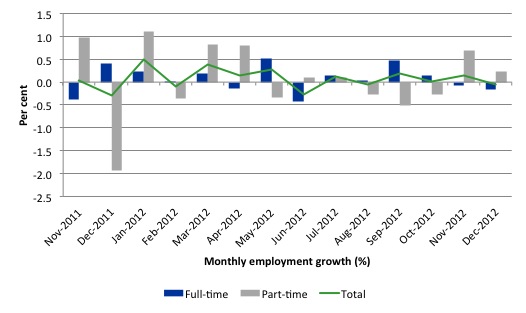

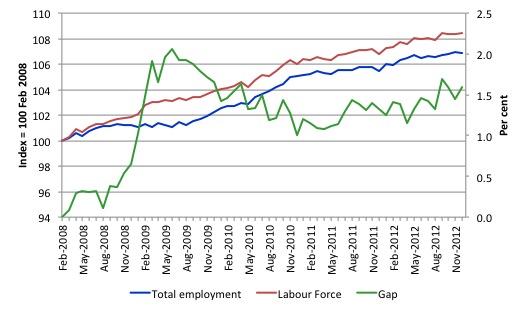
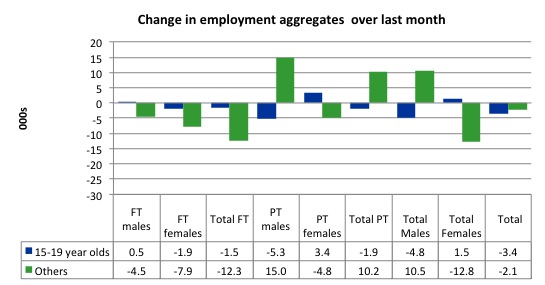
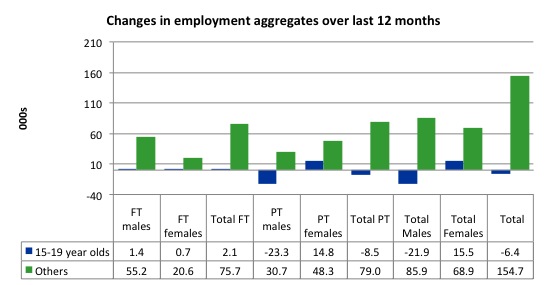
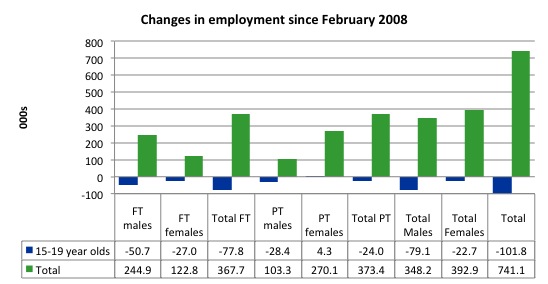
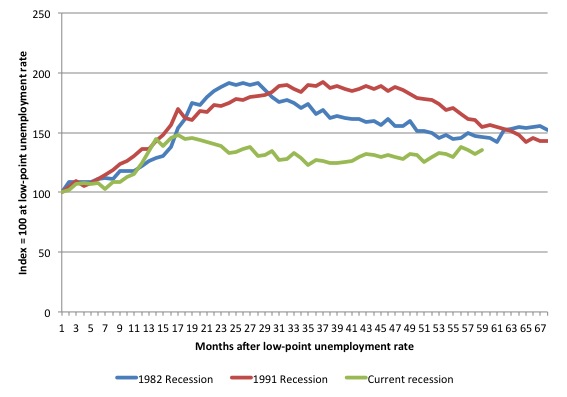
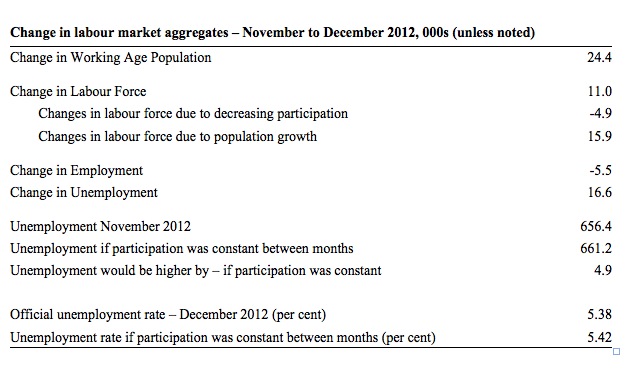
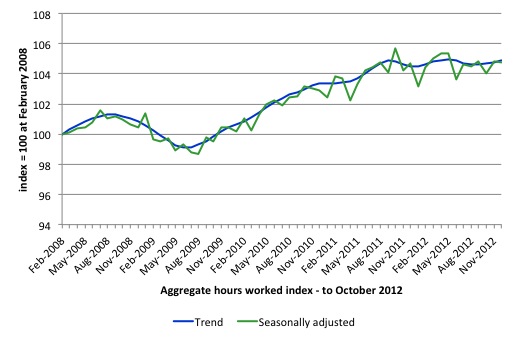
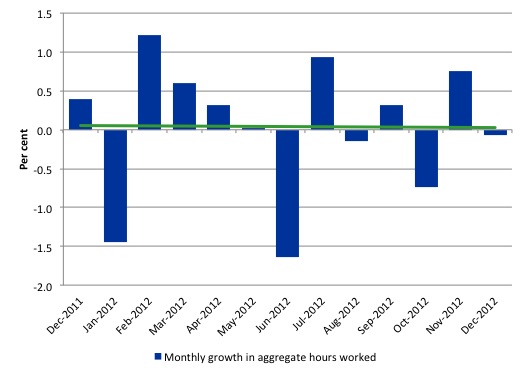
Youth unemployment is not only a disaster for the youth concerned it is a potential social disaster in the not too distant future.
Jobs growth is not keeping pace with population growth but the federal government continues to run a high immigration policy.
These and other indicators seem to mean that the oligarchy is determined to run Australia into the ground.Maybe they are angling for a nice payout from a Chinese takeover bid.
Bill, do you know the current level for the JR2 measure of unemployment here in Australia? About a year ago it was 7% or 8%. I tried working it out from the data cubes couldn’t do it. Cheers.
A lot of whining and complaining about youth unemployment above, with next to no suggestions as to what to do about it. Bill does suggest an “employment guarantee”, but doesn’t enlarge on what that consists of. Is it the same as JG? JG (like the WPA) is suitable for providing work for a variety of different types of labour which temporarily cannot find regular jobs. But it ‘s not suitable for specifically for youth unemployment.
Youths need to start gaining work experience the day they leave school and in the whole range of different sectors of the economy they will eventually find work. A significant proportion of youths also need the freedom to try out a variety of different types of work in different sectors of the economy before they find something they like or which suits them. Many millionaires started off with a variety of dead end jobs.
Personally I can’t see what’s wrong with good old supply and demand in this connection. I.e. just make youths available to employers for free: wage to consist of whatever the youths would have got on benefits. If something is free then at least it gets used in some sort of fashion, if not a desperately productive fashion.
In Victorian times, some apprectices got a NEGATIVE wage. They had to pay for the privilege of being employed for their first year.
It’s a sad reality but the voting public don’t care enough about youth unemployment to force the government to fix the problem.
Big business, Mass media, and the governments they own and control has managed to convince society that youth in Australia are unemployed because they don’t want to work.
Unfortunately, I think youth unemployment has been shuffled towards the bottom of the pack just above Indigenous health.
In most developed countries the ability of business to hire youth is severely circumscribed by government regulation. Teens are legally forbidden to do certain dangerous jobs, their hours may be restricted and they may be covered by minimum wage requirements, all things that decrease their value to potential employers. If unemployment of youth is indeed the problem everyone says it is, these regulations need to be scrapped.
Many millionaires started off with a variety of dead end jobs.
Gideon Osborne springs to mind, a bit of towel folding and data entry before nestling down in the less demanding grotto of the conservatives’ central office.
He seems to be earnestly making your grim dreams come true, workfare and paid for apprenticeships in the form of degrees.
I always thought the victorian era was, for the majority, pretty shit.
If unemployment of youth is indeed the problem everyone says it is, these regulations need to be scrapped.
No they don’t, a job guarantee would work much better. Haiti is pretty light on regulation and it has rather poor employment figures.
Am working slowly through this article. Have been looking a Greg Jericho’s Grog’s Gamut and it seems, according to him, apart from Queensland, things look pretty good.
@ Ralph and Paul
I am in your camp. Reduce the interference by governments and unleash the unknown capacity of personal responsibility, self respect and creative juice. Positive character traits (incl. compassion) are often the product of a certain degree of hardship during one’s life.
Sorry, I meant Raph and Chuck
Dear Linus Huber (At 2013/01/18 at 12:23)
All this talk of creative juices and self respect is the typical denials of neo-liberals and Austrian Schoolers. You can have as much juice as you like and a macroeconomic demand constraint wont move an inch.
Sorry!
best wishes
bill
It’s a little like gonzo writer Joe Bageant put it, “I don’t like middle class people, I just don’t like them. They tend to get smug really fast. Their 401ks (pensions) are on the backs of my brothers…. you look down on these people and they are a culture.” Bageant goes on to describe how the middle class got their education but they didn’t care enough to make sure others got theirs. This is increasingly the issue in Australia as the neo-liberal push moves into education. Milton Friedman left his estate to the privatisation of education. It is about much more than “unleash[ing] the unknown capacity of personal responsibility, self respect and creative juice” as comforting as it must be for the speaker when he says it. I congratulate Bill on the arguments presented in this document. I pointed Counterpunch’s Mike Whitney to this document who described Bill as one of his favourite writers and advised he will read this article with a cup of tea tonight. Thanks Bill for the arguments you make in the interest of fairness and the unemployed. You would have to be blind to miss their value.
@ Bill
[REST OF COMMENT DELETED]
Dear Linus: It has been brought to my attention (with evidence supplied) that most of the text you presented as your own (in the name of Linus Huber) – which I have deleted below – was published elsewhere by someone using a different name. If the work is not your own (or not properly referenced) then it is plagiarism. If it is your own and you choose to masquerade identities on different sites, I find that unacceptable.
I found the comments maniacal at best but as a liberal I chose to let them stand because it appeared you were trying to engage in a civil manner.
But the fact that the work is suspect is one step too far.
I am also putting you back into my moderation queue so that all input from now on can be checked for authenticity. I recommend you desist from commenting in the future to save me the work!
best wishes
bill
@ Bill
I think that you underestimate those young people that are still not yet completely indoctrinated by the philosophy of riding on the bandwagon of the state’s welfare programs in terms of their inventiveness to find new ways. As the saying goes, in times of scarcity or when one is boxed into a corner, the courage and willpower grows enormously. As most probably still live with their parents they definitely are able to explore different work environments at negligible financial burden to their sponsor.
Gee, Paul, what are the unemployment figures for Haiti and how much employment regulation do they actually have?
@ chuck
what are the unemployment figures for Haiti and how much employment regulation do they actually have?
google haiti unemployment:
http://www.indexmundi.com/haiti/economy_profile.html
based on CIA world Factbook
Haiti is a free market economy that enjoys the advantages of low labor costs and tariff-free access to the US for many of its exports. Poverty, corruption, and poor access to education for much of the population are among Haiti’s most serious disadvantages. Haiti’s economy suffered a severe setback in January 2010 when a 7.0 magnitude earthquake destroyed much of its capital city, Port-au-Prince, and neighboring areas.
US economic engagement under the Haitian Hemispheric Opportunity through Partnership Encouragement (HOPE) Act, passed in December 2006, has boosted apparel exports and investment by providing duty-free access to the US. Congress voted in 2010 to extend the legislation until 2020 under the Haitian Economic Lift Act (HELP); the apparel sector accounts for about 90% of Haitian exports and nearly one-tenth of GDP. Remittances are the primary source of foreign exchange, equaling nearly 20% of GDP and more than twice the earnings from exports. Haiti suffers from a lack of investment, partly because of limited infrastructure and a lack of security.
Population below poverty line
80% (2003 est.)
Labor force
4.81 million
note: shortage of skilled labor, unskilled labor abundant (2010 est.)
Labor force – by occupation
agriculture: 38.1%
industry: 11.5%
services: 50.4% (2010)
Unemployment rate
40.6% (2010 est.)
note: widespread unemployment and underemployment; more than two-thirds of the labor force do not have formal jobs
Household income or consumption by percentage share
lowest 10%: 0.7%
highest 10%: 47.7% (2001)
I would have thought a self actualising person like yourself, chuck, could find out for himself.
However, as Kurt Vonnegut said:
We are here to help each other get through this thing, whatever it is
So I’ll have a quick stab
wikipedia says unemployment is around 50%, and:
Widespread unemployment/underemployment; more than two-thirds of the labor force do not have formal jobs (2002 est.)
Which presumably means there must be 2/3rds of the population free to use their creative energies to negotiate their own terms and become millionaires.
The US state department in its 2010 report on haiti says:
While the law protects trade union organizing activities and stipulates fines for those who interfere with this right, in practice the government made little effort to enforce the law. High unemployment rates and antiunion sentiment among some factory workers and most employers limited the success of union organizing efforts. Collective bargaining was nonexistent, and employers set wages unilaterally……
The law also establishes minimum health and safety regulations. The industrial and assembly sectors largely observed these guidelines, but the Ministry of Labor and Social Affairs did not effectively enforce them. No group collected formal data, but unions alleged job-related injuries occurred frequently in the construction and public works sectors. Although they have the legal right to do so, in practice workers could not exercise the right to remove themselves from dangerous work situations without jeopardizing their continued employment……………………….
Government and NGO estimates of the number of restaveks ranged between 90,000 and 300,000. A 2009 survey estimated 225,000 children work as restaveks in urban areas of Haiti alone. The majority of restaveks were girls between the ages of six and 14.Host family exploitation of restaveks typically included forcing the children to work excessive hours on physically demanding tasks without pay or adequate food, not sending them to school, and subjecting them to physical and/or sexual abuse. Girls were generally placed in domestic servitude in private urban homes, while boys more frequently were exploited for labor on farms. Restaveks who did not run away usually remained with the host family until age 14. Labor laws require employers to pay domestic workers over 15 years old, so many host families forced restaveks from the household before that age.
Difficult to see the heavy hand of regulation in there.
While its hard to say who the government is in Haiti post coup, there was an attempt to increase the minimum wage in garment factories to 61 cents an hour, but this was rejected,at Levi’s behest, by the obama administration and they had to settle for 31 cents.
As you can see, the (US at least) government is on your side, maybe you should emigrate, it sounds like your kind of place.
@Bill
Any thoughts of what is going on here ?
Capital stock issues ?
ONS
http://www.ons.gov.uk/ons/dcp171766_295596.pdf
When ONS examined the outputs after these changes, they were not of sufficient quality for
publication. In particular there was concern over the patterns in the data at industry and asset levels
due to the change from SIC2003 to SIC2007. This resulted in the initial delay and subsequent
suspension of the annual bulletin.
ONS published a statement regarding the delay to capital stocks and consumption of fixed capital
on its website in March 2012; this is available from the link in the ‘further information’ section.
Progress update
ONS has been analysing the issues affecting the underlying capital stock data which prevented
publication in March 2012. The detailed breakdown of industries and assets on a SIC2007 basis
varies greatly from the previous SIC2003 basis. There is a series break in 1997 (the first year of
national accounts central system processing) which has led to processing issues. This is due to
post-1997 data having already been collected on/converted to a SIC2007 basis and pre-1997
data being on a SIC2003 basis. ONS has allocated resources to this issue and is in the process of
creating a consistent time series of industries and assets based on the SIC2007 classification.